That’s my mid-Victorian underwear I’m usually wearing under my 1840s, 1850s and 1860s costumes, sometimes with the addition of my other petticoats, such as my tucked or flounced petticoat.
My Victorian chemise is a very simple pattern, knee-length, with a low square neck, tight sleeves and underarm gussets, and without any embroidery . Victorians thought underwear should be plain as it’s never seen – embroidered underwear was considered indecent according to Cunnington’s book ‘History of Underclothes’.
For the chemise I used an old, sturdy, off-white, jacquard self stripe cotton fabric.
‘Shifts are generally made of fine Irish linen or calico, for the upper classes, and of stout linen, or strong but soft calico for poor children. […] There is another mode of cutting out the top of a shift, and, from its simplicity and economy, is preferable to any other. The shoulder-straps are cut separately from the skirt, which is, consequently, cut shorter, and is made quite straight at the top. The shift, after being gored or crossed, has little bosom gores put in front. The top is then hemmed, both before and behind, and the straps put on. A neat frill may be added, to give a finish to the whole.’ (The Workwoman’s Guide, 1840, p. 46/7) Here’s a drawing of the chemise (Plate 6, Figure 2)
The rest of my underwear is made of unbleached calico.
Calico ‘should be soft, without specks, and the threads and selvages even.’ It should also be ‘free from dress, which is a preparation of lime’ to improve the color, which destroys the fibers. ‘The unbleached, or grey, is the best for shifts, boys’ shirts, &c., for the lower orders, being warmer and stronger than the white. (The Workwoman’s Guide, 1840, p. 12)
Common width of calico fabric in the 1840s:
- Unbleached calico: 13 nails – 2 yards 4 nails/ 75 cm – 2,05 m
- Fine white calico for caps, aprons, etc: 12 nail – 1,5 yard/ 70 cm – 1,40 m
- Stout calico: 14 nails – 3 yards/ 80 cm – 2,75 m
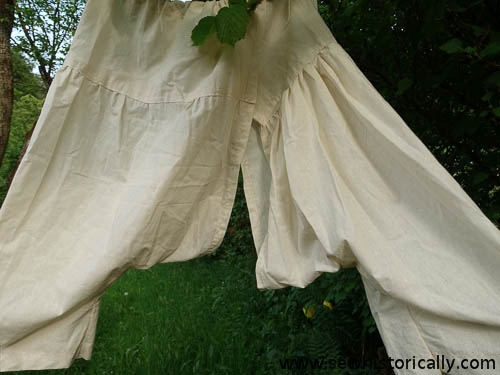
Victorian ladies’ drawers were usually crotchless. Open drawers were considered hygienic.
‘These are worn by men, women, and children of all classes, and almost all ages, under the different names of trowsers and drawers. They are made in a great variety of ways. […] Drawers for ladies and children are usually made of calico, twill, and cambric muslin.’ (The Workwoman’s Guide, 1840, p. 50) Women’s drawers ‘are formed of two separate legs sewed into a band, which is made to button before or behind.’ (The Workwoman’s Guide, 1840, p. 53) Here’s a drawing of the women’s drawers (Plate 7, Figure 11/12)
My petticoat is also made with unbleached calico.
‘Petticoats are made of calico, twill, dimity, cambric, and jaconet muslin, sometimes for mourning, or for wearing under thin dresses of silk and satin: for the middling and lower classes, they are of calico, strong dimity, calamanco, stuff, and bombazine […] Skirts have generally from two, to two and a half breadth in them, according to the width of the material of which they are made: they are sometimes finished at the bottom with a deep hem, three nails broad, tucks, or worked muslin. Sometimes they are bought with cotton runners, woven in them at the bottom, six or eight nails deep, which make the dress stand out, and if the gown is of a clinging material, causes it to hang better.
Skirts are generally made with the opening behind, but for elderly persons or servants, it is at the sides, the seams being left unsewed for about four nails from the top […] Skirts may be […] equally full all round […] or with all the fullness behind. Servants frequently wear their petticoats merely set into a tape round the waist […] Under or middle petticoats are also made in this manner.’ (The Workwoman’s Guide, 1840, p. 104) The plaited skirt is ‘set firmly into a linen, calico, or jean band, of the proper width to encircle the waist, and of 1 nail deep when doubled and turned in. Strong tapes are sewed to the ends of the band, and sometimes a large button-hole is made in the band.’ (The Workwoman’s Guide, 1840, p. 72)
The petticoat actually consists of four petticoats which were separate before each closed with a drawstring closure. However, four separate petticoats were cumbersome, so I combined them into one petticoat.
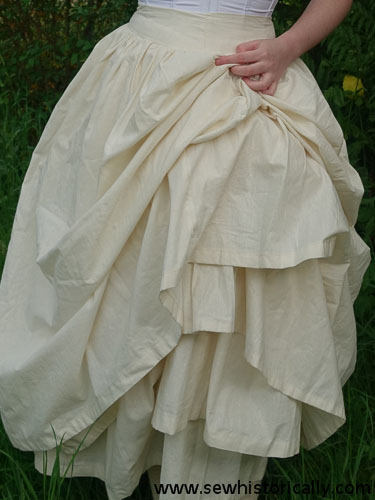
The petticoat has a V-shaped yoke because Victorian dresses usually had a pointed bodice.
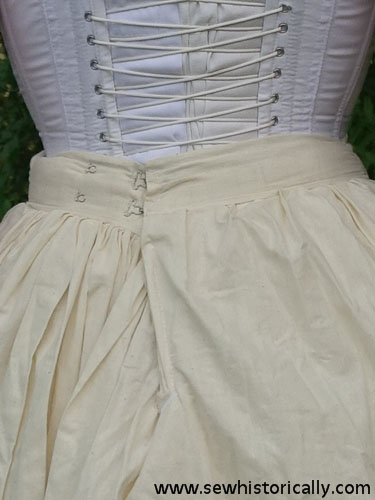
The petticoat has a hook and eye closure in the back. There are four eyes, the waist is adjustable: so I can wear the petticoat with a more or less laced corset depending on which dress I plan to wear.
For the photoshoot I put my hair into a Victorian braided bun. I parted my hair into four sections like here, braided them and put them into a bun.
And taking photos isn’t always easy because during out photoshoot there was a thunderstorm and it began to rain! 😆
References:
- By a lady (1840), The Workwoman’s Guide, London, Simpkin, Marshall, and Co., Stationers’ Hall Court, available at https://archive.org/details/workwomansguide00workgoog, accessed 25/1/2016
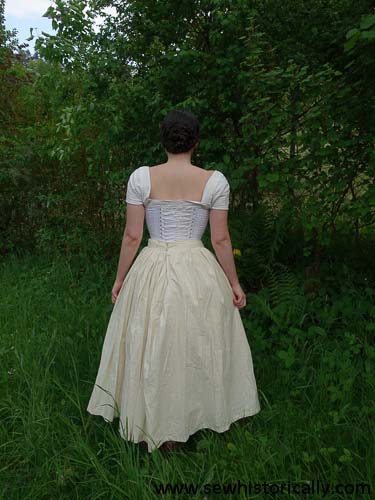
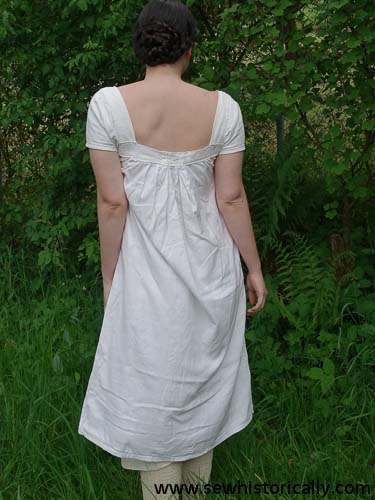
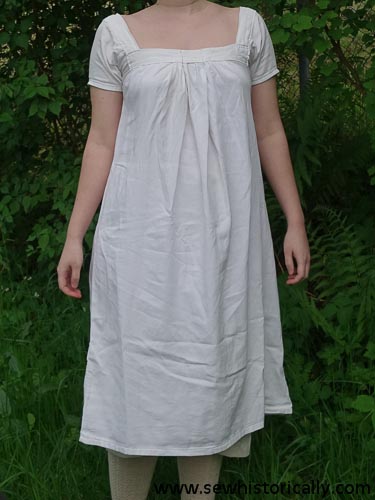
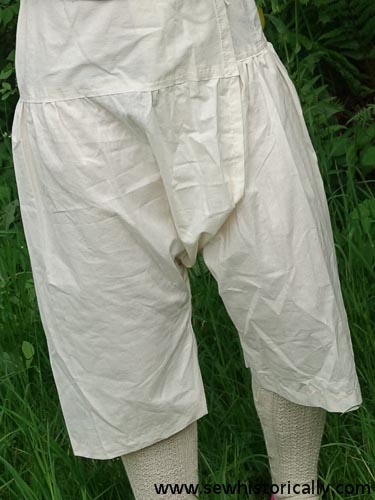
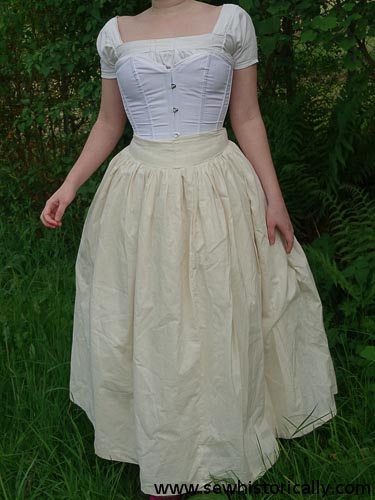
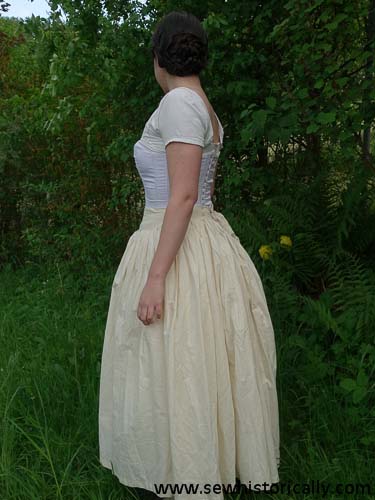
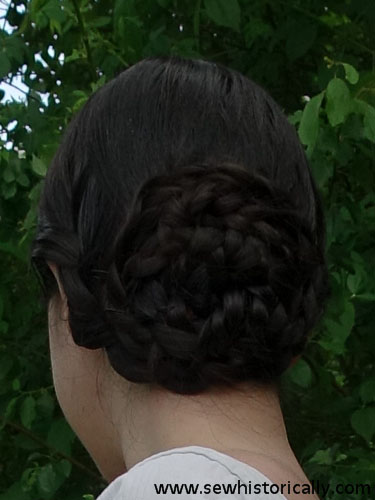
Thank you for sharing at Ravenwould.
Thanks for stopping by, Kileen! 🙂
I’m curious about how you combined 4 petticoats into one. Does each layer go all the way from the waistband to the hem? It appears that each layer is a different length. Is that just arranged that way for the photo? Or does each layer get a little longer to create more of a bell shape?
All layers have the same lengths – they go all the way from the waistband to the hem.
Hi lady. It is funny that your underweare seems like an beautiful disney snow white dress.
I like that chemise a lot, but im getting crazy trying to figure out how to sew it. It seems tight arround the body over the chest, and higher than the back. So its hard to understand the sleeves, gussets, skirt, sewed unions zone, covered by your arms.
I dont know even if the front and the back are simetric, and it seems unsimetric because the bosom keeps it higher. That sounds logic, but in that case, i expect more loose shift.
The book (plate included), doesnt help me, since it looks to me as clear as an advanced chemistry astrological old hebrew grimoire. (The same you think while reading my english. Sorry).
So i would appreciate if you could do something about that. Maybe a close up photo of that part, or a drawing, or some explanation. (Im aware you said it is an “very simple pattern”, but something is tricking me. Maybe the horizontal large rectangle over the chest, wich i dont know if reachs the gussets or not, or goes under them).
Im sure that could help a lot of people, interested like me on that beautiful chemise.
Anyway, thank you for your site, and have a good season (walpurgis night is coming).
Thanks too foor reading this crazy letter.
Thank you! Yes, the front and back are symmetrical and the chemise is almost completely made of rectangles and squares: like the yoke, sleeves and underarm gussets. My chemise is cut similar to this antique linen chemise that I bought some time ago. There are also close-up pictures. 🙂
We are advised, in the book linked at the bottom of this page, to use “cotton” for sewing certain types of fabric, and “thread” for others, because “thread” is more durable. I was previously lead to believe that those two are the same thing. Apparently not; do you know the difference?
I think it’s either linen sewing thread or it means that more strands are twisted together (plied) like twine.